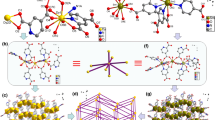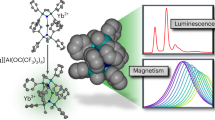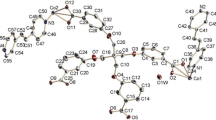Abstract
Detailed studies of the structures, magnetic properties and photodimerization of a series of formato-bridged MOFs with the general formula M2(HCOO)3(4,4′-bpe)3(H2O)3(X) (4,4′-bpe = 4,4′-bipyridylethylene, M = Mn (1-X−), X− = ClO −4 , NO −3 , BF −4 , I−, Br−; M = Co (2 −-X−), X− = ClO −4 , NO −3 ; M = Zn (3-X−), X− = NO3/−) were reported. Careful magnetic measurements on an oriented single crystal of 1-ClO −4 determined the spin-flop magnetic phase diagram and some intrinsic parameters, such as the intralayer coupling J, the anisotropy field H A and the exchange field H E. Different anions can remarkably tune the magnetic properties of 1-X−, especially the critical fields of the spin-flop transition. Compound 2-ClO −4 remained paramagnetic down to 2 K.
Similar content being viewed by others
References
Miller JS, Drillon M. Magnetism: Molecules to Materials. Weinheim: Wiley-VCH, 2002–2005, Vol. I–V
Thompson LK. Special issue on magnetism-molecular and supramolecular perspectives. Coord Chem Rev, 2005, 249: 2549–2730
Coronado E, Dunbar KR. Forum issue on molecular magnetism. Inorg Chem, 2009, 48: 3293–3896
Brechin EK. Themed issue on molecular magnetism. Dalton Trans, 2010, 39: 4671–5038
Miller JS, Gatteschi D. Molecule-based magnets themed issue. Chem Soc Rev, 2011, 40: 3053–3368
Manriquez JM, Yee GT, Mclean RS, Epstein AJ, Miller JS. A room-temperature molecular/organic-based magnet. Science, 1991, 252: 1415–1417
Ferlay S, Mallah T, Ouahès R, Veillet P, Verdaguer M. A roomtemperature organometallic magnet based on Prussian blue. Nature, 1995, 378: 701–703
Miller JS. Magnetically ordered molecule-based materials. Chem Soc Rev, 2011, 40: 3266–3296
Rittenberg DK, Sugiura K, Sakata Y, Mikami S, Epstein AJ, Miller JS. Large coercivity and high remanent magnetization organic-based magnets. Adv Mater, 2000, 12: 126–130
Sessoli R. Record hard magnets: Glauber dynamics are key. Angew Chem Int Ed, 2008, 47: 5508–5510
Gatteschi D, Sessoli R. Quantum tunneling of magnetization and related phenomena in molecular materials. Angew Chem Int Ed, 2003, 42: 268–297
Rinehart JD, Fang M, Evans WJ, Long JR. Strong exchange and magnetic blocking in N 3−2 radical-bridged lanthanide complexes. Nat Chem, 2011, 3: 538–542
Coulon C, Miyasaka H, Clérac R. Single-chain magnets: theoretical approach and experimental systems. Struct Bonding, 2006, 122: 163–206
Bogani L, Vindigni A, Sessoli R, Gatteschi D. Single chain magnets: Where to from here? J Mater Chem, 2008, 18: 4750–4758
Coronado E, Martí-Gastaldo C, Navarro-Moratalla E, Ribera A, Blundell SJ, Baker PJ. Coexistence of superconductivity and magnetism by chemical design. Nat Chem, 2011, 2: 1031–1036
Sato O, Tao J, Zhang YZ. Control of magnetic properties through external stimuli. Angew Chem Int Ed, 2007, 46: 2152–2187
Dechambenoit P, Long JR. Microporous magnets. Chem Soc Rev, 2011, 40: 3249–3265
Rogez G, Viart N, Drillon M. Multiferroic materials: The attractive approach of metal-organic frameworks (MOFs). Angew Chem Int Ed, 2010, 49: 1921–1923
Wang XY, Wang ZM, Gao S. Constructing magnetic molecular solids by employing three-atom ligands as bridges. Chem Commun, 2008. 281–294
Ribas J, Escuer A, Monfort M, Vicente R, Cortés R, Lezama L, Rojo T. Polynuclear NiII and MnII azido bridging complexes. Structural trends and magnetic behavior. Coord Chem Rev, 1999, 193–195: 1027–1068
Escuer A, Aromí G. Azide as a bridging ligand and magnetic coupler in transition metal clusters. Eur J Inorg Chem, 2006. 4721–4736
Wang ZM, Zhang B, Zhang YJ, Kurmoo M, Liu T, Gao S, Kobayashi H. A family of porous magnets, [M3(HCOO)6] (M = Mn, Fe, Co and Ni). Polyhedron, 2007, 26: 2207–2215
Weng DF, Wang ZM, Gao S. Framework-structured weak ferromagnets. Chem Soc Rev, 2011, 40: 3157–3181
Moriya T. Anisotropic superexchange interaction and weak ferromagnetism. Phys Rev, 1960, 120: 91–98
Moriya T. Theory of magnetism of NiF2. Phys Rev, 1960, 117: 635–647
Dzialoshinski I. A thermodynamic theory of “weak” ferromagnetism of antiferromagnetics. J Phys Chem Solids, 1958, 4: 241–255
Wang XY, Wang L, Wang ZM, Gao S. Solvent-tuned azido-bridged Co2+ layers: Square, honeycomb, and kagomé. J Am Chem Soc, 2006, 128: 674–675
Liu T, Zhang YJ, Wang ZM, Gao S. A 64-nuclear cubic cage incorporating propeller-like FeIII 8 apices and HCOO− edges. J Am Chem Soc, 2008, 130: 10500–10501
Wang XY, Wang ZM, Gao S. Detailed magnetic studies on Co(N3)2(4-acetylpyridine)2: A weak-ferromagnet with a very big canting angle. Inorg Chem, 2008, 47: 5720–5726
Wang ZM, Zhang B, Inoue K, Fujiwara H, Otsuka T, Kobayashi H, Kurmoo M. Occurrence of a rare 49·66 structural topology, chirality, and weak ferromagnetism in the [NH4][MII(HCOO)3] (M = Mn, Co, Ni) frameworks. Inorg Chem, 2007, 46: 437–445
Xu GC, Ma XM, Zhang L, Wang ZM, Gao S. Disorder-order ferroelectric transition in the metal formate framework of [NH4][Zn(HCOO)3]. J Am Chem Soc, 2010, 132: 9588–9590
Xu GC, Zhang W, Ma XM, Chen YH, Zhang L, Cai HL, Wang ZM, Xiong RG, Gao S. Coexistence of magnetic and electric orderings in the metal-formate frameworks of [NH4][M(HCOO)3]. J Am Chem Soc, 2011, 133: 14948–14951
Li MY, Kurmoo M, Wang ZM, Gao S. Metal-organic niccolite: Synthesis, structures, phase transition, and magnetic properties of [CH3NH2(CH2)2NH2CH3][M2(HCOO)6] (M = divalent Mn, Fe, Co, Ni, Cu and Zn). Chem Asian J, 2011, 6: 3084–3096
Wang ZM, Zhang YJ, Liu T, Kurmoo M, Gao S. [Fe3(HCOO)6]: A permanent porous diamond framework displaying H2/N2 adsorption, guest inclusion, and guest-dependent magnetism. Adv Funct Mater, 2007, 17: 1523–1536
Jain P, Ramachandran V, Clark RJ, Zhou HD, Toby BH, Dalal NS, Kroto HW, Cheetham AK. Multiferroic behavior associated with an order-disorder hydrogen bonding transition in metal-organic frameworks (MOFs) with the perovskite ABX3 architecture. J Am Chem Soc, 2009, 131: 13625–13627
Zhao JP, Hu BW, Lloret F, Tao J, Yang Q, Zhang XF, Bu XH. Magnetic behavior control in niccolite structural metal formate frameworks [NH2(CH3)2][FeIIIMII(HCOO)6] (M = Fe, Mn, and Co) by varying the divalent metal ions. Inorg Chem, 2010, 49: 10390–10399
Wang XY, Wei HY, Wang ZM, Gao S, Chen ZD. Formates-the analogue of azide: Structural and magnetic properties of M(HCOO)2(4,4′-bpy)·H2O (M = Mn, Co, Ni; n = 0, 5). Inorg Chem, 2005, 44: 572–583
Ghosh AK, Ghoshal D, Zangrando E, Ribas J, Chaudhuri NR. Rare azido-bridged manganese(II) systems: Syntheses, crystal structures, and magnetic properties. Inorg Chem, 2005, 44: 1786–1793
Niel V, Muñoz MC, Gaspar AB, Galet A, Levchenko G, Real JA. Thermal-, pressure-, and light-induced spin transition in novel cyanide-bridged FeII-AgI bimetallic compounds with three-dimensional interpenetrating double structures {FeIILx[Ag(CN)2]2}·G. Chem Eur J, 2002, 8: 2446–2453
Matouzenko GS, Jeanneau E, Verat AY, Bousseksou A. Spin crossover and polymorphism in a family of 1,2-bis(4-pyridyl)ethene-bridged binuclear iron(II) complexes. A key role of structural distortions. Dalton Trans, 2011, 40: 9608–9618
MacGillivray LR. From engineering crystals to engineering molecules: emergent consequences of controlling reactivity in the solid state using linear templates. CrystEngComm, 2002, 4: 37–41
Toh NL, Nagarathinam M, Vittal JJ. Topochemical photodimerization in the coordination polymer [{(CF3CO2)(μ-O2CCH3)Zn}2(μ-bpe)2]n through single-crystal to single-crystal transformation. Angew Chem Int Ed, 2005, 44: 2237–2241
Varshney DB, Gao XC, Friščić T, MacGillivray LR. Heteroditopic Rebek’s imide directs the reactivity of homoditopic olefins within desolvated quaternary assemblies in the solid state. Angew Chem Int Ed, 2006, 45: 646–650
Wang XY, Wang ZM, Gao S. A pillared layer MOF with aniontunable magnetic properties and photochemical [2 + 2] cycloaddition. Chem Commun, 2007, 1127–1129
SHELXTL, Version 5.1, Bruker Analytical Systems, Madison, WI 1997
Schmidt GM. Photodimerization in the solid state. J Pure Appl Chem, 1971, 27: 647–678
Rushbrook GS, Wood PJ. On the Curie points and high temperature susceptibilities of Heisenberg model ferromagnetic. Mol Phys, 1958, 1: 257–283
Carlin RL. Magnetochemistry. Berlin Heidelberg: Springer-Verlag, 1986
Wang XY, Wang L, Wang ZM, Su G, Gao S. Coexistence of spin-canting, metamagnetism, and spin-flop in a (4,4) layered manganese azide polymer. Chem Mater, 2005, 17: 6369–6380
Author information
Authors and Affiliations
Corresponding authors
Electronic supplementary material
Rights and permissions
About this article
Cite this article
Wang, X., Wang, Z. & Gao, S. Detailed magnetic study on the formato-bridged MOFs with anion-tunable magnetic properties. Sci. China Chem. 55, 1055–1063 (2012). https://doi.org/10.1007/s11426-012-4561-6
Received:
Accepted:
Published:
Issue Date:
DOI: https://doi.org/10.1007/s11426-012-4561-6




